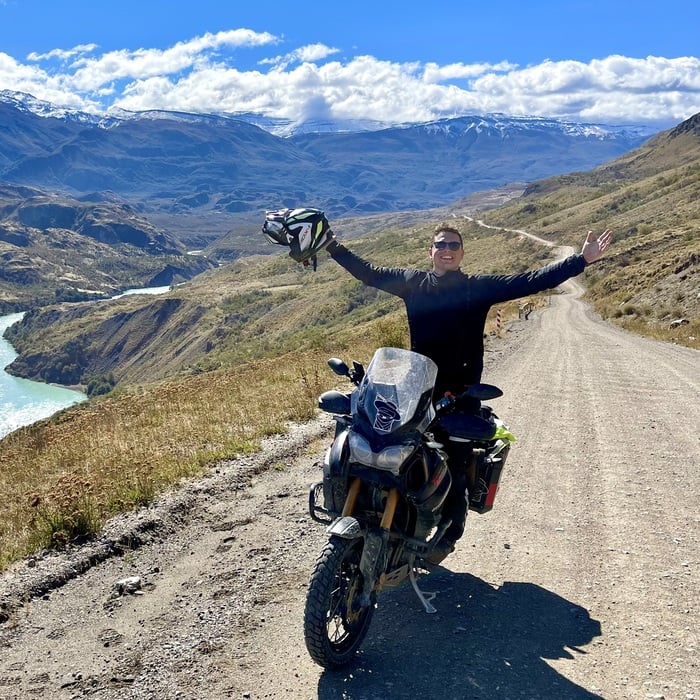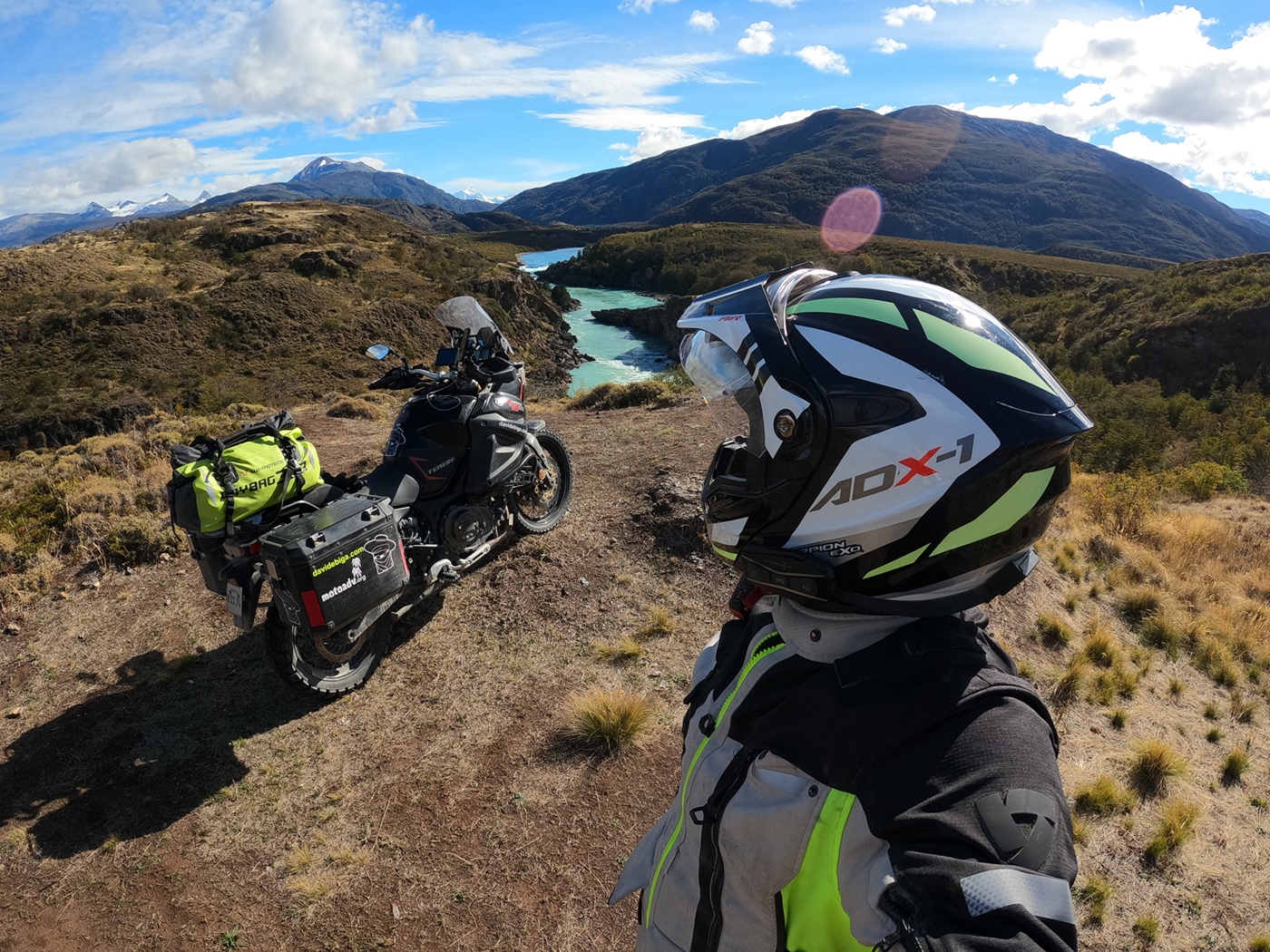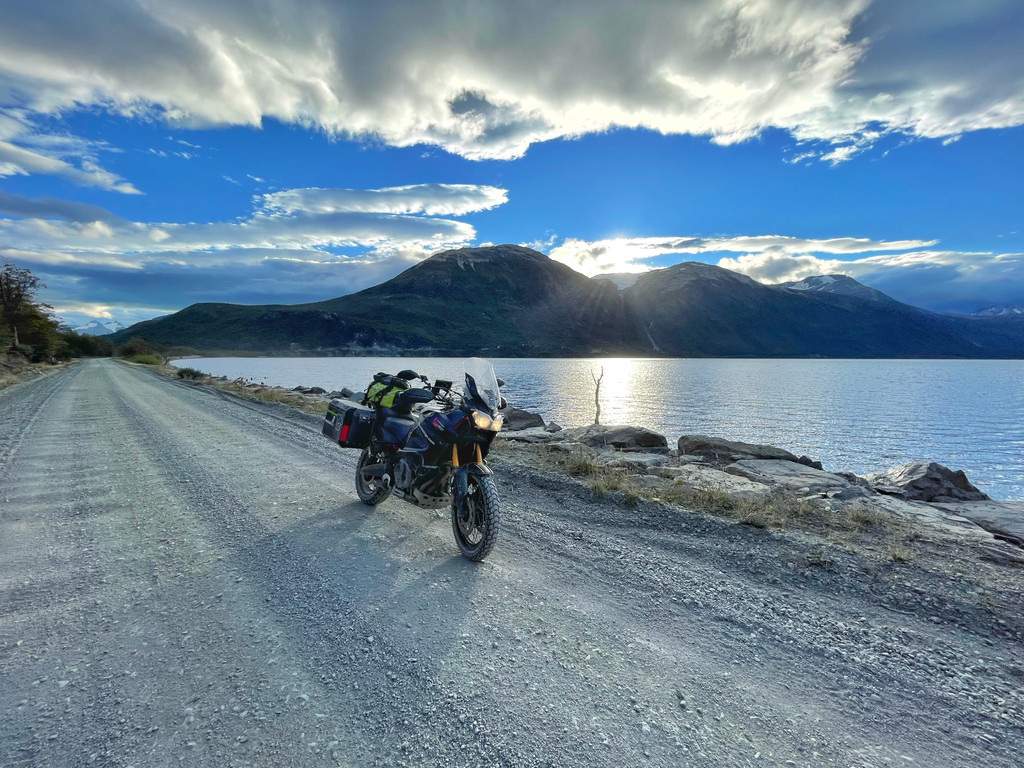
I’m Alex Di Muzio, 30 years old, a rider from the age of 4 through the passion passed on by my father. After traveling by 4x4 between Iran, Turkey, North Africa and the Balkans for years, I switched to biking. My favorite trip? The one I still haven’t taken.
Planning a trip is part of the trip itself, allowing us to set off in our imaginations, finding out about maps, places we’re going to visit, roads we’re going to travel, but meticulous planning has never been one of my strengths, still less months and months before setting off.
Managing work independently lets me, as in this case, organize a trip on the other side of the world in a month or so.
That’s how it was in early February 2022. Covid-19 restrictions were still prohibitive worldwide, and I wanted to return to South America on a motorcycle after an incredible experience in pre-pandemic Colombia. Patagonia, the famous Carretera Austral, coveted destinations for all travelers, but for us motorcycle riders maybe a little more…
There’s that mystical something, which together with the idea of being so far from home, in such a wilderness, holds a special fascination, to me like the song of the Sirens seeking to lure Odysseus towards the rocks.
You can get past the restrictions on entering Chile, but it takes a lot of paperwork. The days when we could travel over the world with just a passport in our pockets seems far away.
That’s the first question I asked myself when I was organizing a trip to Chile.
Both cost a lot, but the question to ask that could tip the balance has to be “How much time will I have for this trip?” If we’re talking months then it will be much cheaper to ship our bike from Italy by sea, but if like me you only have 15 days, renting is by far the best choice.
With rental you’ll have no problems with customs clearance, paperwork, various shipments, and you’ll have a bike ready to use, not to mention the period when the bike will be in transit and you can’t use it if you decide to ship it.
Finding a good renter, with vehicles in good condition, is essential. You need to make sure the documents are in order, then the appropriate rental agreement will allow you to have your experience in safety.
Summer in Chile runs from December to early March. You have to bear in mind that the country is more than 4,000 km long, so in summer you can go from 30/35 °C in Santiago de Chile, in the center, to 10/15 °C in Villa O'Higgins, the southernmost point of the Carretera Austral.
Another famous destination, the Atacama Desert in the north, is also recommended from June to August.
So there isn’t really a time you’d be advised against going to Chile. The physical geography of the country means that all seasons are ideal for organizing a trip. If you want to miss out on the cold and the rain, present to a greater or lesser extent in the various areas of the country, you should definitely avoid setting off in the winter season (though it’s generally the cheapest holiday period). If instead you want to avoid crowds of tourists and high prices, you’d better avoid travelling in the high season, summer (in the Southern Hemisphere).
After about 16 hours total travel time, with a stopover at London Heathrow, here I am in Santiago, Chile, for my second motorcycle trip in South America.
I decide to stay a day and a half in Santiago, the first half day to set up my Yamaha Super Ténéré rented from my friend Davide Biga and recover from jet lag (Chile is 6 hours behind Italy).
The next day, to get acquainted with my new traveling companion, I head for the Argentine border to tackle the Paso Los Libertadores, a winding road with 18 hairpin bends, designed by an artist on the Cordillera of the Andes at an altitude of 3200 meters.
As always... the best things happen by chance, without planning, so I decide to go exploring all the way to the Argentine border, when I encounter a sign pointing to a dirt road to the Cristo Redentor de los Andes (Christ the Redeemer of the Andes).
In one of my best decisions on this trip, I climb this dirt road in the middle of the Andes for about 40 minutes without meeting a soul until I arrive at 3800 meters at the famous Cristo Redentor.
It’s a unique feeling – and to think that this is only my first day in Chile. Who knows what’s in store for me on the rest of the trip?

Back in Santiago, I find myself among the chaotic celebrations of the new Chilean President, Boric, a really important day for the people of Chile. The new President is only 36, and there are hopes of a breath of fresh air for this country.
It’s time to set off for the south, for the real journey that I’ve been dreaming of for so long. First I have to cover the 900 or so kilometers of tedious highway separating me from Villarica.
Unfortunately, I only have 15 days on the motorcycle in practice, so choices have to be made – deciding what to see and what, sadly, to miss out on.
As I said, I’m not a great planner. I like to live day by day. I do have a general outline, but I haven’t booked anything except a ferry, which you need if you want to complete the Carretera. I like to get caught up in events, meet people and be open to new experiences, without necessarily saying, “I have to get all the way there today. I booked the hotel here.”
From Villarica to Puerto Varas there’s an expanse of lakes and volcanoes not to be missed. Riding the road along Lake Llanquihue with Volcán Osorno in front is really thrilling. It reminds me of the spectacular photos of Mount Fuji in Japan, very similar in shape.
The weather in these first few days of the trip has always been mild – sunny, clear skies, the ideal temperature for a motorcycle trip. I enjoy the 5-hour crossing from Hornòpiren to Caleta Gonzalo, which is unavoidable if you want to go south. That was the only thing I had to book well in advance. This stretch really reminds me of Norway, a real fjord, surrounded by nature, with mountains alongside the ocean, which moves in between them. I begin to breathe the air of Patagonia.
You realize you’re somewhere magical when you wake up in the morning, walk along the beach outside your forest cabana and see four dolphins swimming near the shore.
I look at the map and see “how far south I am in South America”, not far from Ushuaia and Cape Horn. I don’t even have the time to put on my helmet and set off towards Coyhaique before the weather reminds me that it’s unpredictable here. I take on more than 550 km with rain that feels like the sky falling on my head, passing through the famous Paso Queulat. They tell me it’s an incredible place, but I only remember the fog with visibility down to 3 meters, the water running down my back and the fear of running out of gas. But it was a good experience.
From Coyhaique you feel that something has changed, as if there were a different air and atmosphere. This city, with 57,000 inhabitants, is the biggest in this area of Chile, where I’ll return at the end of my trip to take the plane that will bring me back to Santiago on a flight of about 2 hours and 15 minutes.
The Carretera Austral officially begins in Puerto Montt, ending 1240 km later in Villa O'Higgins.
Work on building this road, ordered by dictator Augusto Pinochet, began in 1976 and ended in 1996.
Designed for military purposes, it crosses regions otherwise unreachable except by sea and for about 700 km is completely unpaved. Just after Villa Cerro Castillo I find the famous “Fin Pavimento” sign – the real Ruta por el Sur begins, the one I’ve dreamt of for a long time.
Miles and miles into nowhere, solo, on dirt roads, just me and my bike, with the road proceeding in a straight line as far as the eye can see between forests, lakes and rivers, when suddenly the colors of General Carrera Lake take a starring role.
The lake is shared, half in Argentina as Lake Buenos Aires and half in Chile as General Carrera Lake, as I said.
Emanuel, my guide on the boat tour to the Catedral de Marmol, one of the most famous attractions in Patagonia, explains to me that the locals call it Lake Chelenko.
The Catedral is made up of marble, right in the middle of the lake, that centuries of erosion have sculpted into statues, giving rise to an authentic open-air museum.
The tour costs about €30 for two and a half hours starting from Puerto Rio Tranquilo, a small village on the west coast of the lake.
From Puerto Rio Tranquilo to Cochrane is one of the most captivating stages of the whole trip – Bertrand Lake with its magical colors, the Rio Baker where I had the first rafting experience of my life, the Confluencia of the Rio Neff and Rio Baker that leaves you speechless, and the last 20 km towards Cochrane, where I keep laughing in my helmet due to the euphoria of that moment.
The destination of my trip is Villa O’Higgins, fin de la Carretera Austral. To get there, I have to take another ferry, taking me from Caleta Yungay to Rio Bravo. I arrive at the embarkation point 3 hours before departure. There isn’t a soul around, just a big deserted space, so in total tranquility I open the pantry of my Super Ténéré. Today’s snack consists of apples, walnuts, potato chips and cookies – three Michelin stars, which will do the job.
For hundreds of miles you might not run into anything or anyone on the Carretera, so always having gas, water and something to eat is essential.
We disembark at Rio Bravo, a few travelers with cars, bicycles, a few hitchhikers, three motorcycles… I’m the only European. In company there are a few locals bringing supplies to the last outpost of civilization in this area of Patagonia.

The last 100 km are mystical, total nothingness, sheer nature, and you realize how small your space in the world is. After 3,500 km from Santiago, Chile, I arrive at the Fin de la Carretera Austral, solo. I’m happy!
I have more than 600 km ahead of me on the same road as the outward journey back to Coyhaique. I’ll leave the bike and take a flight back to Santiago, Chile.
I’ve always loved traveling both ways on the same route. It lets you see the landscape from a new, different perspective, lets you catch glimpses of things you sometimes wouldn’t see, so going back over the Carretera Austral is a joy to me.
On the way I take the opportunity to make a small detour to Caleta Tortel, one of the most famous and touristic villages in the area, built almost entirely on stilts surrounding the fjord on which it sits.
I feel I should offer some advice to those who perhaps are taking on a trip to South America – in this case Chile – for the first time.
Before setting off, take out foreign travel insurance.
Check the expiration on your passport, validity of at least 6 months from expiration.
Buy a Chilean SIM for your smartphone at one of the hundreds of stalls you’ll find on the streets of Santiago – ENTEL recommended.
You can always pay for gasoline at gas stations with a credit card, even in the most remote villages.
To take on the Carretera Austral it’s best to have a range of at least 250 km; with a classic adventure bike you’ll have no trouble refueling, as long as you do it whenever you have the chance.
If you’re traveling alone in high season, you’ll have no problem finding a cabanas for the night, but if you’re in a group I recommend booking in advance. Cabanas are the equivalent of a hytte in Norway, little houses that sometimes also have a kitchen and a wood stove for heating. I paid €30–80 for a cabanas with 2/4 beds depending on the location.
The language… we Italians have an advantage, understanding Spanish. After a few days you’ll also start to say a few words, whereas English isn’t known very well.
Motorcycle rental: a maxi adventure like the Yamaha Super Ténéré 1200 costs about €200 a day in Chile.
